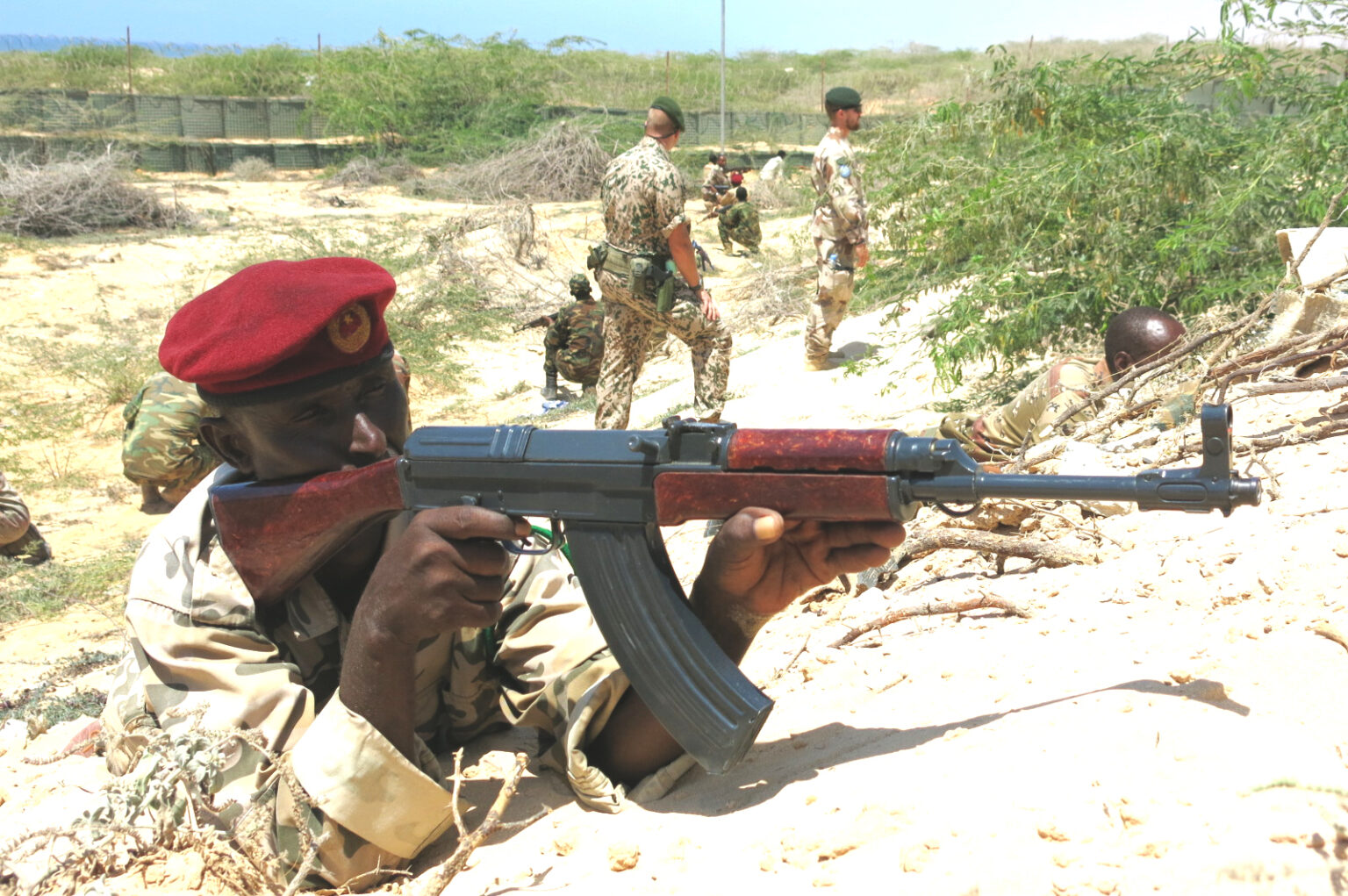
This July, the Biden administration picked up where former President Donald Trump left off and began bombing Somalia, a country with a gross domestic product of less than $6 billion and a poverty rate of 70 percent. But why?
The official reason provided by the Pentagon was that the Somali National Army needed air support in its operations to counter al-Shabaab. But the actual reason was that Somalia is geo-strategically important to U.S. empire.
Successive U.S. administrations have cycled through a myriad of excuses to either bomb the country or to arm its dictators: Cold War politics, “humanitarian intervention,” anti-piracy and, more recently, counterterrorism.
As we shall see, in the mid-2000s, a fragile coalition of soft and hard Islamists — explicitly not allied to Al Qaeda at the time — brought some measure of peace to the areas of Somalia it controlled. With help from Britain and neighboring Ethiopia, the U.S. smashed the coalition and pushed more right-wing elements like al-Shabaab over the edge into militancy.
And of course, the global superpower bombing one of the poorest countries on Earth in the name of national security is not terrorism.
Let’s take a look at the broader context and specific chronology.
US Imperial Bulwark Born in Africa
The Pentagon has divided the world into self-appointed Areas of Responsibility (AORs). The Southern Command deems itself “responsible” for operations in Central and South America, regardless of what the people of the region think.
The Central Command (CENTCOM) covers much of the Middle East and Central Asia: the key intersections of energy fields and pipelines that enable the U.S. to influence the global economy at the expense of competitors, notably Russia and China.
The Africa Command (AFRICOM) was founded in 2007 by the George W. Bush administration and is based in Stuttgart, Germany. President Barack Obama vastly expanded its operations.
AFRICOM’s current AOR covers 53 of the continent’s 54 states, with Egypt in the northeast already under the AOR of CENTCOM due to its strategic value (more below).
AFRICOM recently bragged about how it helped coordinate with Somali “partners,” meaning elements of the regime imposed on the country by the West, to organize the Biden-led bombing of al-Shabaab.
AFRICOM says: “The command’s initial assessment is that no civilians were injured or killed given the remote nature of where this engagement occurred.” But who knows?
U.S. commanders operating in the African theater have tended to dismiss the notion that civilian deaths should be tallied at all. In 1995, for example, the U.S. wound down its “assistance” to the UN mission in Somalia, but ended up in a shooting war in which several Somalis died. The U.S. commander, Lt. Gen. Anthony Zinni, said at the time, “I’m not counting bodies… I’m not interested.”
Geopolitical Importance
In the Africa-Middle East regions, three seas are of strategic importance to the big powers: the Mediterranean, the Red Sea (connected by Egypt’s Suez Canal), and the Gulf of Aden, which is shared by Somalia in Africa and Yemen in the Middle East.
Through these seas and routes travel the shipping containers of the world, carrying oil, gas, and consumer products. They are essential for the strategic deployment of troops and naval destroyers.
Somalia was occupied by Britain and Italy during the “Scramble for Africa,” the continent-wide resource-grab by Western colonial powers that began in the late-19th century. Ethiopia continues to occupy Somalia’s Ogaden region.
A 1950s’ British Colonial Office report described the Gulf of Aden as “an important base from which naval, military and air forces can protect British interests in the Persian Gulf and the Arabian Peninsula.” “British” interests, like “U.S.” interests today, means elite interests.
A George W. Bush-era report by the U.S. Army War College notes that, “Even before the Suez Canal came into being, the [Red] Sea had been of importance as an international waterway. It served as a bridge between the richest areas of Europe and the Far East.” The report emphasizes that the “geopolitical position of the Red Sea is of a special importance.”
AFRICOM was founded with a grand imperial ambition: to make the four of the five countries on Africa’s Red Sea coast — Djibouti, Eritrea, Somalia, and Sudan — comply with U.S. elite interests, and to keep the Sea, Gulf of Aden, and Suez Canal open for business and strategic deployment.
As noted before, CENTCOM covers Egypt. During the Arab Spring a decade ago, U.S. strategists feared, like their British predecessors, that losing the Suez Canal to a democratic government in Egypt “would damage U.S. capabiliti
es to mobilize forces to contain Iran and would weaken the overall U.S. defense strategy in the Middle East,” home of much of the world’s accessible oil.
Interference Drives Somalia’s Civil Conflict
Somalia declared independence in 1960. Its British and Italian areas merged into a single nation led by President Aden Abdullah Osman and Prime Minister Abdirashid Ali Shermarke, who later became president. Most political parties merged with the Somali Youth League to create a de facto single-party state.
Backed by the West, Ethiopia blocked Somalia’s diplomatic efforts to reclaim the Ogaden region. As president, Abdirashid took millions of dollars in Soviet military assistance and was subsequently assassinated by one “Said Orfano,” a young police-trained man posing as a cop and erroneously referred to in contemporary sources as a “bodyguard.”
Major General Siad Barre took over in 1969 and ruled until his overthrow in 1991. An early-1970s CIA intelligence memo refers to Russian-Somali relations as “largely a liaison of convenience,” marred by “mutual” “distrust.”
After Barre’s failed war with Ethiopia over Ogaden and his explicit rejection of Soviet money and ideology, the U.S. saw him as a client. In 1977, senior U.S. policymakers highlighted Somalia’s “break with the Soviets.” From then until 1989, the U.S. gave nearly $600 million in military aid to Barre’s regime to nudge it further from the Soviet sphere of influence.
The Barre regime used the newly augmented military — from 3,000 to 120,000 personnel — to crush the rival Somali National Movement, killing tens of thousands of civilians and driving a million people from their homes.
But the coalition that deposed Barre in 1991 fell apart and the rival factions fought a civil war that triggered famine and killed an additional 300,000 people within the first couple of years.
The United Nations intervened to deliver food to civilians. The U.S. saw the move as an opportunity to test the new doctrine of “humanitarian intervention” in the form of Operation Restore Hope. President George H.W. Bush said that the objective was to “save thousands of innocents from death.”
But a master’s thesis by Major Vance J. Nannini of the U.S. Army’s Fort Leavenworth provides a version of events much closer to the truth:
“Throughout our involvement with Somalia, our overriding strategic objective was simply to acquire and maintain the capability to respond to any military contingency that could threaten U.S. interests in the Middle East, Northeast Africa and the Red Sea area.”
Restore Hope ended in a fiasco for the U.S., exemplified by the famous Black Hawk Down incident, and thousands of Somali deaths — “I’m not counting bodies,” as Commander Zinni said of a later mission.
Convenient Target in ‘War on Terror’
In Djibouti in 1999, a Transitional National Government (TNG) was formed in exile and came to power in the Somali capital, Mogadishu, in 2001.
At the same time, a broad umbrella of Sufis and Salafists — the “left” and “right” of Islam — known as the Islamic Courts Union (ICU) was gaining political and territorial ground.
The TNG collapsed in 2004 and was replaced with a Transitional Federal Government founded in Kenya and backed by the Ethiopian proxy Abdullahi Yusuf, a man harbored by Britain and even given a liver transplant in the U.K. (The liver allegedly came from an Irish Republican Army member. “Now I am a real killer,” joked Abdullahi.)
Abdullahi was found liable for damages in a U.K. court over the killing of a British citizen in Somalia in 2002 by his bodyguards.
Under the post-9/11 rubric of fighting a “war on terror,” the CIA added to the chaos throughout the period by covertly funding non-Islamist “warlords,” including those the U.S. previously fought in the 1990s. The aim was to kill and capture ICU members and other Islamists.
In addition, the Pentagon’s secretive Joint Special Operations Command (JSOC) engaged in covert operations. Estimates of the number of JSOC personnel on the ground in Somalia range from three to 100.
U.S. Special Forces set up a network of operations and surveillance in the country, supposedly to counter al-Qaeda.
In 2003, for instance, U.S. agents kidnapped an innocent man, Suleiman Abdullah Salim, from a Mogadishu hospital. Claiming that he was an “Al-Qaeda” operative, the U.S. had Suleiman tortured at a number of “rendition” sites before releasing him. (The operatives who grabbed him were tipped off by the “warlord” Mohammed Dheere, who was paid by the CIA.)
But one of the Arabic meanings of “Al-Qaeda” is “the database,” referring to the computer file with information on the tens of thousands of mujahideen and their acolytes trained, armed, organized, and funded by the U.S. and Britain throughout the 1980s to fight the Soviets (Operation Cyclone).
There are more direct links between the U.S. and al-Shabaab. In his younger days, ICU secretary and later al-Shabaab leader Ahmed Abdi Godane joined the only major terrorist group in Somalia in the 1990s, Al-Itihaad al-Islamiya (AIAI, “Islamic Union”). The AIAI fighters trained with “Al-Qaeda” in Afghanistan in the 1980s, when the U.S. and Britain were training “Al-Qaeda.”
Killing Somalia’s Hope
By the mid-2000s, with the rise of the ICU, the hope of stability came to Somalia — but it was not to last. In 2003, the U.S. Combined Joint Tasks Force Horn of Africa initiated training of Ethiopia’s military in tactics, logistics and maintenance. The U.S. backing later came in handy fighting the ICU.
The ICU was rapidly and widely painted as an extremist organization. However, a Congressional Research Service (CRS) report notes that it was “well received by the people in the areas the Courts controlled,” particularly as it provided social services.
Western propaganda spun the ICU’s shutting down of cinemas as proof of its Islamo-fascism. But the CRS report says that such measures were undertaken at the request of parents because children were skipping school, “not because of the Courts’ alleged jihadist and extremist ideology… There is no evidence to support the allegation that women were prohibited from working.”
As Western vessels continue to deplete starving Somalia’s fish stocks to sell to comparatively privileged consumers, propaganda denounces Somali “piracy” against Euro-American ships.
However, a report by the Royal Institute for International Affairs (the British think tank also known as Chatham House), says: “The only period during which piracy virtually vanished around Somalia was during the six months of rule by the Islamic Courts Union in the second half of 2006.”


